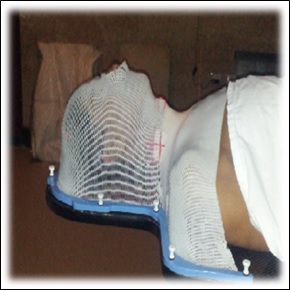The necessity of replanning during the intensity-modulated radiotherapy (IMRT) for head and neck cancer, to ensure adequate coverage of target volume
Abstract
Introduction: In head and neck cancer the location, size, shape of disease, and normal anatomy change in 6-7 weeks radiotherapy. As a result, steep dose gradients move across target and critical structures resulting in underdose to target and overdose to critical structures.
Aim: comparison of target coverage in initial IMRT plan and replan and to quantify dose changes to normal structures in two plans.
Methods and Material: 30 patients with locally advanced head and neck cancer patients planned for curative radiotherapy were selected and treated with 3DCRT plan. For dosimetric comparison IMRT plan was created for pre-treatment and repeat CT, which was done after 40Gy.
Statistical analysis used: Statistical methods (student’s paired t-test) were applied.
Results: Both PTV coverage (V95 from 96.29±1.12 to 97.33±0.80) and dose (D95 from 66.64±0.87 to 67.57±0.74) increased in replanned CT. Both max and mean doses to the brainstem and spinal cord along with mean dose to parotid glands increased in replanned CT.
Conclusions: Replanning is necessary during mid-treatment to accommodate anatomical and dosimetric changes during curative radiotherapy.
Downloads
References
Chao KC, Deasy JO, Markman J, Haynie J, Perez CA, Purdy JA, et al. A prospective study of salivary function sparing in patients with head-and-neck cancers receiving intensity-modulated or three-dimensional radiation therapy: Initial results. Int J Radiat Oncol Biol Phys. 2001;49(4):907-916. doi: https://doi.org/10.1016/s0360-3016(00)01441-3.
Eisbruch A, Kim HM, Terrell JE, Marsh LH, Dawson LA, Ship JA. Xerostomia and its predictors following parotid-sparing irradiation of head-and-neck cancer. Int J Radiat Oncol Biol Phys.2001;50(3):695-704. doi: https://doi.org/10.1016/s0360-3016(01)01512-7.
Barker Jr JL, Garden AS, Ang KK, O'Daniel JC, Wang H, Court LE, et al. Quantification of volumetric and geometric changes occurring during fractionated radiotherapy for head-and-neck cancer using an integrated CT/linear accelerator system. Int J Radiat Oncol Biol Phys. 2004;59(4):960–970. doi: https://doi.org/10.1016/j.ijrobp.2003.12.024.
Hansen EK, Bucci MK, Quivey JM, Weinberg V, Xia P. Repeat CT imaging and replanning during the course of IMRT for head-and-neck cancer. Int J Radiat Oncol Biol Phys. 2006;64(2):355-362. doi: https://doi.org/10.1016/j.ijrobp.2005.07.957.
Robar JL, Day A, Clancey J, Kelly R, Yewondwossen M, Hollenhorst H, et al: Spatial and dosimetric variability of organs at risk in head-and-neck intensity-modulated radiotherapy. Int J Radiat Oncol Biol Phys. 2007;68(4):1121-1130. doi: https://doi.org/10.1016/j.ijrobp.2007.01.030.
Castadot P, Lee JA, Parraga A, Geets X, Macq B, Grégoire V. Comparison of 12 deformable registration strategies in adaptive radiation therapy for the treatment of head and neck tumors. Radiother Oncol 2008;89(1):1-12. doi: https://doi.org/10.1016/j.radonc.2008.04.010.
O'Daniel JC, Garden AS, Schwartz DL, Wang H, Ang KK, Ahamad A, et al. Parotid gland dose in intensity-modulated radiotherapy for head and neck cancer: is what you plan what you get?. Int J Radiat Oncol Biol Phys.2007;69(4):1290-1296. doi: https://doi.org/10.1016/j.ijrobp.2007.07.2345.
Han C, Chen YJ, Liu A, Schultheiss TE, Wong JY. Actual dose variation of parotid glands and spinal cord for nasopharyngeal cancer patients during radiotherapy. Int J Radiat Oncol Biol Phys. 2008;70(4):1256-1262. doi: https://doi.org/10.1016/j.ijrobp.2007.10.067.
Lee C, Langen KM, Lu W, Haimerl J, Schnarr E, Ruchala KJ, et al: Assessment of parotid gland dose changes during head and neck cancer radiotherapy using daily megavoltage computed tomography and deformable image registration. Int J Radiat Oncol Biol Phys. 2008;71(5):1563-1571. doi: https://doi.org/10.1016/j.ijrobp.2008.04.013.
Hunt MA, Kutcher GJ, Burman C, Fass D, Harrison L, Leibel S, et al. The effect of setup uncertainties on the treatment of nasopharynx cancer. Int J Radiat Oncol Biol Phys. 1993;27(2):437-447. doi: https://doi.org/10.1016/0360-3016(93)90257-v.
Osorio EM, Hoogeman MS, Al-Mamgani A, Teguh DN, Levendag PC, Heijmen BJ, et al. Local anatomic changes in parotid and submandibular glands during radiotherapy for oropharynx cancer and correlation with dose, studied in detail with nonrigid registration. Int J Radiat Oncol Biol Phys. 2008;70(3):875-882. doi: https://doi.org/10.1016/j.ijrobp.2007.10.063.
Mohan R, Zhang X, Wang H, Kang Y, Wang X, Liu H, et al. Use of deformed intensity distributions for on-line modification of image-guided IMRT to account for inter fractional anatomic changes. Int J Radiat Oncol Biol Phys. 2005;61(4):1258-1266. doi: https://doi.org/10.1016/j.ijrobp.2004.11.033.
Kuo YC, Wu TH, Chung TS, Huang KW, Chao KS, Su WC, et al. Effect of regression of enlarged neck lymph nodes on radiation doses received by parotid glands during intensity modulated radiotherapy for head and neck cancer. Am J Clin Oncol. 2006;29(6):600-605. doi: https://doi.org/10.1097/01.coc.0000239093.95769.b3.
Geets X, Tomsej M, Lee JA, Duprez T, Coche E, Cosnard G, et al: Adaptive biological image-guided IMRT with anatomic and functional imaging in pharyngo-laryngeal tumors: Impact on target volume delineation and dose distribution using helical tomotherapy. Radiother Oncol. 2007;85(1):105-115. doi: https://doi.org/10.1016/j.radonc.2007.05.010.
Castadot P, Lee JA, Geets X, Grégoire V. Adaptive Radiotherapy of Head and Neck Cancer Semin Radiat Oncol. 2010;20(2):84-93. doi: https://doi.org/10.1016/j.semradonc.2009.11.002.

Copyright (c) 2020 Author (s). Published by Siddharth Health Research and Social Welfare Society

This work is licensed under a Creative Commons Attribution 4.0 International License.


 OAI - Open Archives Initiative
OAI - Open Archives Initiative


